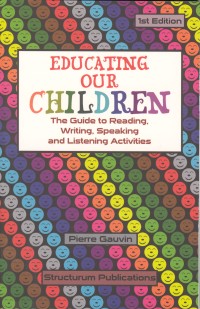| ________________
CM . . .
. Volume XII Number 10 . . . .January 20, 2006 
 |
Educating Our Children: The Guide to Reading, Writing, Speaking and Listening Activities.
Pierre Gauvin.
Timmins, ON: Structurum Publications, (70-C Mountjoy St. North, Suite 327, P4N 4V7), 2004.
237 pp., pbk., $24.95.
ISBN 0-9733849-1-3.
Subject Headings:
Language arts.
English language-Study and teaching-Activity programs.
Language arts (Elementary).
English language-Study and teaching (Elementary)-Activity programs.
Professional.
Review by Gina Varty.
**** /4 |
| |
|

excerpt:
Contrary to popular belief, education in not measured in grade point averages or percentage points. To be educated means to know how to use something, to make it your own, to develop it from within. Education should be the result of practical activities, an application of knowledge. (p. vi)
Activities must be relevant to the children's lives, connecting their leaning to their own experience and the world around them, and varied enough to keep them stimulated. (p. vii)
The hundreds of happy faces on the cover of this book are an indication of what lies within. An idea-seeking parent or teacher will find over 200 activities guaranteed to put a smile on the face of even the most reluctant learner. Educators will smile, too, as the activities are adaptable to almost any subject, grade level and learning environment.
Subtitled The Guide to Reading, Writing, Speaking, and Listening Activities, this book features language-oriented activities that can be played individually as well as in small teams. Each chapter focuses upon a different language skill: spelling, reading, writing, speaking, listening, and a catchall sixth chapter entitled "overall activities."
Whether the learner learns visually, through listening, or by manipulating objects, there are activities in this book to get everyone participating. Small and large group interaction encourages communication and the exchange of new ideas. The imagination is awakened through activities that involve role playing and walking in someone else's shoes.
Opportunities for thinking, problem solving and experimenting are provided with each activity. It is in interacting with others and playing for fun that learning takes place. Here are a couple of my favourite activities from the book:
Spelling
also: scrambled words, grids and codes
p. 16 Categories to fill in—categories run down the left side of a page (e.g. food, animals) and letters that will head each column run along top of page (e.g. A food = Apple).
p. 26 Drawing in the air—learners convey a message with either back to or facing teammates. Time each group with stopwatch.
p. 56 Spelling using CB code words—(or Greek letters) learners are asked to spell words using code words for each letter. Foxtrot Uniform November (FUN)
Reading
also: syllables, letter tiles and flashcards
p. 86 Reading in unison
p. 91 The search for—learners look for words or answers to questions from a newspaper, magazine, catalogue or phone book.
Writing
also: written conversations, and new versions of stories
p. 128 Pen pal between classes
p. 134 The alphabet in consecutive words—learners write sentences with words that follow the alphabet's order (all big cats drink) or that cover the alphabet in no particular order.
Speaking
also: puppets, eye spy and debates
p. 171 Skits using 5 objects—learners may be limited by theme, time or number of participants.
p. 186 Who knows where this is going?—learners tell a story using single words or an entire sentence.
Listening
also: Simon says and blindfolded movement
p. 188 Back to back—can learner 2 draw what learner 1 describes when sitting back to back?
p. 197 Three lies one truth... or, three truths and one lie—learners share insight into their pasts, others determine what is true and what is fabricated.
Over-all Activities
also: blackboard and target games
p. 213 Step game—correct answers bring learners closer to the finish line.
The activities are arranged alphabetically in each chapter. Each activity features a white on black (blackboard) image of the activity and an easy-to-follow description that includes materials, variations, and expected outcome. Some of the activities require advanced preparation (flashcards, collections of objects, supply of paper rolls). This, in itself, could be a preliminary activity for the learners. The activities also require various equipment and supplies: chalkboard, whiteboard, projectors, construction paper, etc. These are readily accessible in the classroom, less so at home. However, adapting the activities to suit the learner and the environment at hand is part of the fun.
An interesting feature of this book is the index. Instead of the typical alphabetical list with page numbers, this book has a quick picture index by chapter. There are 13 or 15 blackboard images per page which are clearly laid out under each type of activity (spelling, reading, writing, etc.). Educators can tell at a glance the activities for any given language skill and can easily find the page for a particular activity that fits a given lesson.
Pierre Gauvin, the author, describes himself as a "traveling educator and transmitter of knowledge, helping learners of all ages through activities that promote the practical use of information." He has created a work of edutainment, a manual full of activities that challenge, build self- confidence, and inspire creativity: activities where the educator and learner switch roles; activities that give everyone the opportunity of playing while learning at the same time, thus resulting in happy faces all around.
Highly Recommended.
Gina Varty, a librarian in Edmonton, AB, currently provides library supply for Edmonton Public Schools.

To comment
on this title or this review, send mail to cm@umanitoba.ca.
Copyright © the Manitoba Library Association. Reproduction for personal
use is permitted only if this copyright notice is maintained. Any
other reproduction is prohibited without permission.
NEXT REVIEW |
TABLE OF CONTENTS FOR THIS ISSUE
- January 20, 2006.
AUTHORS |
TITLES |
MEDIA REVIEWS |
PROFILES |
BACK ISSUES |
SEARCH |
CMARCHIVE |
HOME |
